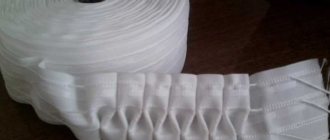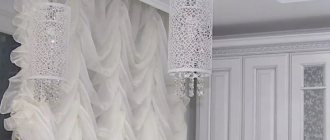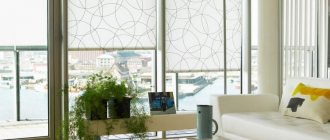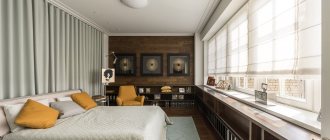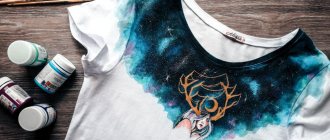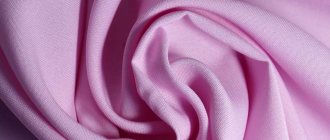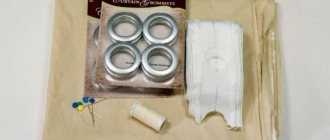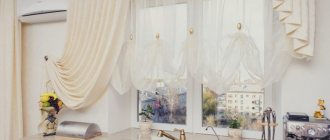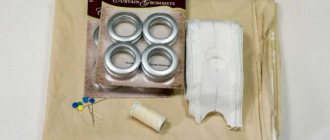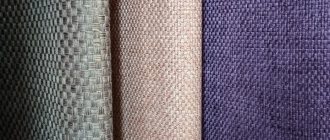Requirements for fabrics for curtains
When choosing textiles for sewing curtains, it is necessary to take into account special points. This primarily concerns the requirements that home curtains must meet. These include:
- practicality and easy care. If fabrics become dirty very quickly and stains are difficult to remove, they are not suitable for home use;
- the manufacturing material must be hypoallergenic;
- fabrics should not collect static electricity. Curtains with this property will be good dust collectors in the house;
- the presence of strong seams and edging. After regular washing, at least twice a month, seams and draperies may come apart. There is no point in altering such options;
- property of “artificial ironing”. After cleaning, many curtains wrinkle, but the fact that the fabric is always straight is ideal for those who do not have time to put textiles in order.
When purchasing matte fabrics, it is advisable to take into account the visibility of fiber weaves. This creates an interesting accent PHOTO: allshtori.ru
Depending on the room for which the curtain will be chosen, it makes sense to pay attention to the density of the fabric from which it is sewn.
Practical curtains
The most practical are curtains made of 100% polyester or with the addition of cotton. Such products can easily be washed in a washing machine in warm water, unlike curtains made of linen, cotton fabrics, and velvet.
Viscose curtains are very practical, and they are also fire-resistant, which is especially important for the kitchen.
It is better to decorate window openings in a hall or office with taffeta curtains, since this material is smooth, silky and durable, it plays and shines in many shades. Thanks to this, the interior becomes more presentable and luxurious.
Silk and cotton fabrics quickly fade and lose their attractiveness. They are incredibly pleasant to the touch and beautiful in appearance, which is why they remain popular among consumers.
Types of textiles for curtains: what are home curtains made from?
The fabric options from which curtains are made are usually divided into three groups. Based on this classification, you can make a choice in favor of one or another option.
Delicate translucent fabrics are suitable as a base and addition to windows PHOTO: fabricmix.ru
Textiles with natural composition
Collectible curtain models are made from natural fabrics. These include linen, cotton, and wool. These materials lend themselves well to dyeing, embroidery and draping. In short, they behave ideally during the entire preparation for the sale. The advantages of this textile include:
- hypoallergenic;
- breathability;
- ease of care.
In natural fabrics, the interlacing of fibers is usually clearly visible. Some models even have to be prepared manually PHOTO: tesdecor.ru
As for the minuses, there are a little more of them. This:
- rapid burnout;
- loop deformation;
- loss of aesthetic appearance;
- wrinkled fabrics that are difficult to mechanically iron;
- the need for special care that will help the color return.
Such fabrics are created by weaving, so at the slightest tear they begin to unravel from the edges. Repairing such curtains is very expensive.
Artificial fabrics
Artificial textiles include polyester, organza, jacquard, and viscose. These options quickly attract attention with their colors. Curtains made from this type of material can be machine washed, after which they do not lose their quality. The advantages of artificial materials include:
- elementary care;
- inexpensive cost even to order;
- the ability not to wrinkle;
- maintaining the brightness of colors after exposure to sunlight;
- a large assortment.
On artificial fabrics, embroidery with satin stitch or ribbons is often acceptable. PHOTO: tessutidelarte.com
Usually, non-natural textiles are complemented with various ornaments or patterns, which is why the price increases PHOTO: shtoshtory.ru
However, disadvantages cannot be excluded:
- become a source of allergies;
- When closed, they do not allow air to pass through.
In addition, polyester and organza are susceptible to the formation of static electricity and, as a result, dust concentration on them.
Mixed
Such fabrics contain both natural and synthetic fibers. Therefore, it is impossible to talk about the absolute safety of such options for the home. Combined fabrics look very elegant, although they are part of a series of economy class fabrics.
As for the advantages, they are multiplied by the combination of two matters. When producing such raw materials, manufacturers try to avoid poor qualities.
If the dye remains on your hands when palpating the fabric, you should not purchase such a model. This is a fake PHOTO: lunafabric.by
Related article:
How to beautifully hang curtains with or without a cornice, on eyelets, loops, ties, rings; different ways to tie curtains: soft ribbons, magnet, pin; how to hang tulle and curtains - read the publication.
Fabric made from natural raw materials
There are several types of fabrics used when sewing curtains. These are products made from raw materials of natural and artificial origin. In addition, there are fabrics made from synthetics and mixed fibers. All natural products are made from fibers of plant and animal origin.
Attention! The advantage of natural fabrics is their absolute environmental friendliness, but the main disadvantage is their relatively high cost.
A large selection of fabrics and patterns will satisfy any designer’s imagination
The group of natural fabrics includes:
- Cotton with all practical characteristics. It is distinguished by durability, strength, and the ability to repel dust and prevent the accumulation of static electricity. At the same time, it is easily washed and ironed well by exposing it to damp steam. If we consider the disadvantages of cotton fabric, then they include an increased tendency to fade under the influence of sunlight and to partially run off when washing.
- Linen - the fabric has a rough texture and a unique structure, and has increased mechanical strength. It is worth remembering that after washing it may shrink. It is very easy to iron if you use wet steaming. In addition, linen does not accumulate static electricity on its surface, does not form lint, and due to its massiveness and high density, it easily forms good folds.
- Wool. There is not only dense fabric for curtains of varying degrees of hairiness, but also those types that have a smooth texture and a small thickness. Wool is less susceptible to contamination, but it absorbs various odors well, so this fabric requires frequent cleaning. It is recommended to ventilate curtains made of this material periodically. In addition, moths can appear in the folds of such fabric.
- Silk. It is considered one of the most expensive materials for sewing curtains, as it looks great, is very durable and has a small thickness. The material is moth-resistant and does not accumulate static electricity; it is very capricious and requires a special washing and drying regime.
Combine curtains with blinds for a stunning effect
All fabrics made from natural raw materials have their own characteristics, both in sewing and in the use of products made from them, so if you don’t know what kind of fabric gabardine is, before using such curtains, study reviews about them on the Internet. If there are a lot of negative reviews about linen when used, for example, in the kitchen, try to replace this material with a more suitable fabric. Otherwise, the fabric will not last long, and the room you decorate with it will look ugly.
Options for common curtain fabrics
If you are unable to independently choose the appropriate style of ready-made curtains, then you can purchase custom-made curtains. However, here too there is difficulty in choosing. Let's look at the most popular ones that are used for curtains in modern homes.
For indoor combined curtains, you should choose textiles of the same brightness PHOTO: horeca.pasionaria.ru
Linen and matting
Linen fabrics are considered to be of high quality and safe, as they do not contain allergic components. Density and rigidity allows you to shade the room well, which is sorely lacking in the hot season. Linen washes well and does not fade in the sun.
Expensive fabric, which in the type of weave resembles ordinary burlap PHOTO: kupitul.ru
By the type of weave of threads, matting can be distinguished from other materials PHOTO: respect-decor.ru
The matting has a rough texture, so sometimes its surface is fleecy. Differs in the quality of fiber weaving. They are arranged in a checkerboard pattern. The material does not require special care and does not deform after cleaning. The only drawback is the inability to straighten puffs left by pets.
Organza and tulle
Organza is a great option for kitchens. The fabric is translucent and wrinkle-resistant. Such textiles are suitable not only for floor-length curtains, but also as a basis for other interior accessories.
It has the excellent ability to create a rich atmosphere in the house PHOTO: kupitul.ru
A familiar fabric for window decoration, which can be sewn in an interesting design PHOTO: hoff.ru
Tulle can have different structures. Usually, when choosing curtains, this material is used as an addition. As a rule, such an accessory has a thin base. Often, this is a mesh translucent fabric.
Jacquard and satin
Jacquard curtains can be used as a bright addition to furniture made from the same material and with the same colors. Textiles are easy to care for and can be washed at home. After a thorough spin, it is important to immediately hang the fabric on the ledge. This will prevent the curtains from wrinkling.
You can't help but fall in love with this fabric. How talented can textiles for curtains be designed? PHOTO: tver.m4y.ru
Tightening on this material is inevitable PHOTO: fry-fry.ru
Satin is considered a heavy fabric, so it is often used for curtains. From this material you can create night curtains of various styles; they can easily withstand drapery. The fabric has a glossy front side and is practically not see-through. Such curtains create excellent shading in the room.
Kisey and taffeta
Kisey is a translucent fabric, the curtains from which are universal and can be used for any room in the house. The material is completely transparent, it can be used not only for sewing basic curtains, but also for spectacular lambrequins.
When making curtains from muslin, the finished model is often supplemented with beads PHOTO: sptema.ru
A peculiar chameleon fabric with interesting tints PHOTO: vplate.ru
Taffeta is used to make a lot of home textiles, including curtains. The material is distinguished by its shine and the ability to form chic voluminous folds. The compressed material will make the most unusual curtains. They can be created in different styles. Taffeta is considered a delicate fabric and therefore requires special care. Washable in slightly warm water with care product.
Flock and gabardine
Flock can have a different base: cotton, viscose, polyester and nylon. Therefore, the finished material has different pile densities. Flock curtains are wear-resistant, practical and pleasant to the touch. The texture of the fabric is made in such a way that dirt can be easily removed from it.
If you look closely, the texture of the flock has microscopic “bald patches”, which has a great effect on the style of the curtains PHOTO: 9yunya.rf
A material that can be easily edged without the risk of seams coming apart PHOTO: fry-fry.ru
Gabardine is a fairly durable material with a fine-ribbed fiber structure. Textiles have a water-repellent property, due to which they are used even in bathrooms and on terraces. It is easy to care for gabardine - it can be washed in a machine and does not require ironing. Over time, the material does not fade or stretch, so it has an attractive appearance for a long time.
Satin and chenille
Satin is a material that is pleasant to the touch and comes in a variety of colors. Often used for sewing night curtains and tulle. The material drapes well and can be washed delicately. However, if used incorrectly, it wrinkles. Wrinkles can only be smoothed out using steam treatment.
In appearance it resembles satin. Satin is very pleasant to the touch PHOTO class-dance.ru
The soft structure of the material for sewing curtains is not often used in its pure form PHOTO: sofme.ru
Chenille is a fabric with a special weave of threads. It is elastic and does not shrink after washing. However, when treated with water at a contrasting temperature, deformation is inevitable. The fabric is dyed with special products that do not fade when washed and do not fade over time.
Veil and blackout
One of the most common fabrics used at home for sewing curtains is considered to be voile. This material has a translucent texture that lends itself to creating various designs. The surface of the fabric is matte, so marks from wet spots remain on it.
To prevent the veil from unraveling, the bottom edge is hemmed and edged on the sides with tape PHOTO: kupitul.ru
Blackout is a very comfortable and practical textile. Curtains made from it create good shading in the room, protect the room from the penetration of ultraviolet rays, debris, dust and wind. The denser structure of the canvas will also hide some sounds.
Classic curtains are often made from blackout fabric PHOTO: dekoriko.ru
Velvet and brocade
Velvet material lends itself well to draping, so it can be used to create interesting sweets that highlight a specific design. Even after washing, the soft pile remains elegant and rich. Textiles can have patterns in the form of monograms or be solid.
Velvet with a mirror tint looks great in rooms with a small area PHOTO: spb.yapokupayu.ru
Brocade is an artificial fabric that is used for sewing curtains and thick tulles. The fabric drapes easily, practically does not wrinkle and does not fade. Such models can be washed in a machine at a temperature not exceeding 30ºС.
Brocade almost always has embroidery with silver PHOTO: fry-fry.ru
On a note! When purchasing fabrics for sewing curtains for your home, you need to focus on items that will not be prone to absorbing odors.
Natural fabrics
The choice of natural fabrics that are suitable for window decoration is very large.
Silk fabrics are distinguished by their sophisticated appearance, noble beauty, elegance and high price.
Atlas is ideal for decorating a large room with a wide window or portal. Silk is associated with a satiny sheen; it is one of the brightest and most recognizable fabrics.
Satin, woven only from silk threads without the addition of synthetics and cotton, is recognizable by its flowing texture. Although natural silk is very expensive, satin without additives does not hold its shape at all and does not drape well, so designers advise using mixed fabrics.
Silk organza , on the contrary, shines with all the colors of the rainbow if it does not contain synthetic impurities. This airy fabric serves as tulle in sets with curtains, and is also used independently on windows in bedrooms and for decoration.
Organza has a significant drawback. Since it is woven from high-quality silk, over time, under the influence of sunlight, the protein loses its plasticity and the fabric becomes less durable. In order to extend the life of organza, it is better to hang it away from direct sunlight.
Cotton is another favorite among curtain fabrics. Its main advantage is durability and ease of maintenance.
For the manufacture of curtains, mercerized fabrics are best suited, that is, treated with caustic soda and dried in autoclaves at high temperature and pressure. Mercerization changes the structure of cotton fiber, making it voluminous and shiny. The paint in dyed fabrics holds excellently, the material does not fade and fades after many years of use.
Satin is a cotton fabric in which the threads are intertwined in the same way as in classic silk satin. Satin has a smooth surface, noble matte shine and elastic texture. Thanks to the durable coloring, you can combine fabrics of different rich colors in one model and be sure that the curtains will not fade during washing.
Satin is used to create fashionable curtains with loops, as they drape beautifully. The only thing that is not suitable for cotton curtains is tiebacks, as this material wrinkles easily.
Chintz - cotton fabric with a plain weave is used in interiors in Provence or country style; such curtains look great in the kitchen and nursery. Any cotton curtains, and chintz curtains especially, do not require a complex cut or elaborate decorations.
The fabric dictates the style of the curtain, and cotton is a material with a pronounced texture; it is an active decorative element. Cotton curtains are successfully combined with Roman blinds, laconic blinds or without any companion at all. Cotton symbolizes simplicity, even if it is made in bright colors, so in the interior you should adhere to the concept of minimalism and modesty.
Linen is a bright accent for an interior in an ecological style. Modern manufacturers paint it in various colors, but the texture of the fabric requires it to be used in light-colored interiors. In combination with linen, bright accents, contrasts and active decorative elements are inappropriate. Despite its apparent simplicity, linen is a very capricious material.
How to choose curtain and tulle fabrics for different rooms
Natural curtain fabric is considered the best option for use at home. As for tulle, it should not have a composition that causes allergies or emit an unpleasant odor. Which material to choose depending on the purpose of the room, we will consider in the section below.
Living room and kitchen
A room where guests are always invited should not be full of bright shades of tulle and fabrics. Everything in this room is based on calm, pleasant conversations. Accordingly, the material should be light and unobtrusive. Curtains made of natural and light textiles are ideal for decorating windows in the living room. With modern design, the use of thick curtains is allowed, provided that they are collected in chic folds and folds.
Related article:
Curtains for the living room in a modern style: photo. In this article we will take a detailed look at the types of curtains, how to choose the right curtains depending on the style of the apartment or house, and other useful tips from designers.
It is advisable to hang curtains made of heavy fabrics on durable metal curtain rods PHOTO: yandex.uz
In the kitchen, it is important to use only practical materials on the windows. It is desirable that they have dirt-repellent properties. At the same time, curtains must withstand repeated changes in temperature and humidity. When choosing, keep in mind that the textiles will have to be washed a lot. Mesh tulle, voile and jacquard can be safely used to decorate guest rooms, kitchens and dining rooms.
Related article:
Modern curtains for the kitchen. Photos of new models, varieties of styles and rules for their selection, requirements for fabric material, photo review of long and short products - read in our publication.
Bedroom and children's room
The bedroom is the only place where you can calmly relax and recover after hard everyday life. Therefore, the general atmosphere here should be relaxing. To do this, you need to choose material for curtains with unobtrusive shades. Dark opaque textiles for curtains and translucent satin tulle are an excellent option. As for colors, it is better to focus on the overall design of the room and the tones that predominate in the interior.
Curtains in a children's room can have loops in the form of knots. For such models, it is better to use fabric that will not unravel randomly PHOTO: happymodern.ru
When choosing fabrics for curtains in a child's room, you need to remember their practicality and hypoallergenicity. A small amount of synthetics in the fabric is welcome. This will make it the most durable and wear-resistant. When it comes to colors, you can fantasize without limits. Bright, patterned, transparent, pastel colors - all this can be used either alone or in combination, emphasizing the overall design of the bedroom.
Color solutions
There is even greater variety in terms of colors and prints. Depending on the color of your room, you can choose darker or lighter curtains.
The simplest and most neutral colors are white, beige, and coffee. You can also choose beautiful colored fabrics: pink, burgundy, blue.
The main thing to consider here is how well the color of the curtains combines with the color of the wallpaper or other fabrics in your room.
To learn how to choose the right curtain color, watch the following video.
Video: options for popular and harmless fabrics for home curtains
When choosing a material, you should always focus on what function they should perform. If these are dense materials, then they are suitable for night curtains, but light and transparent thread materials are more likely a model for window decoration.
Dear readers, if you have something to tell and add on this topic, write to us in the comments. Also, don’t forget to rate the article and ask questions. Our team is happy to receive feedback, so we will definitely answer you.
Save time: selected articles delivered to your inbox every week
